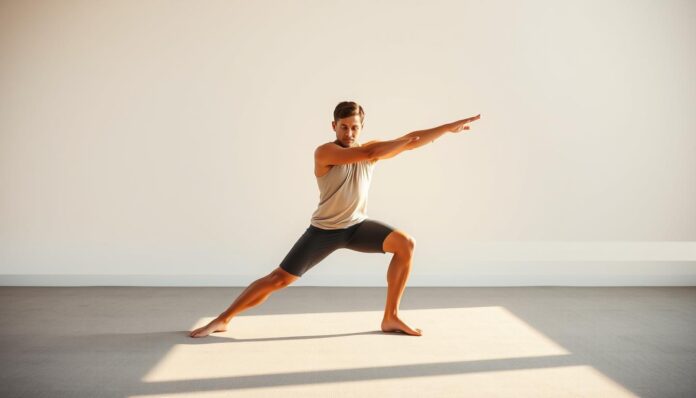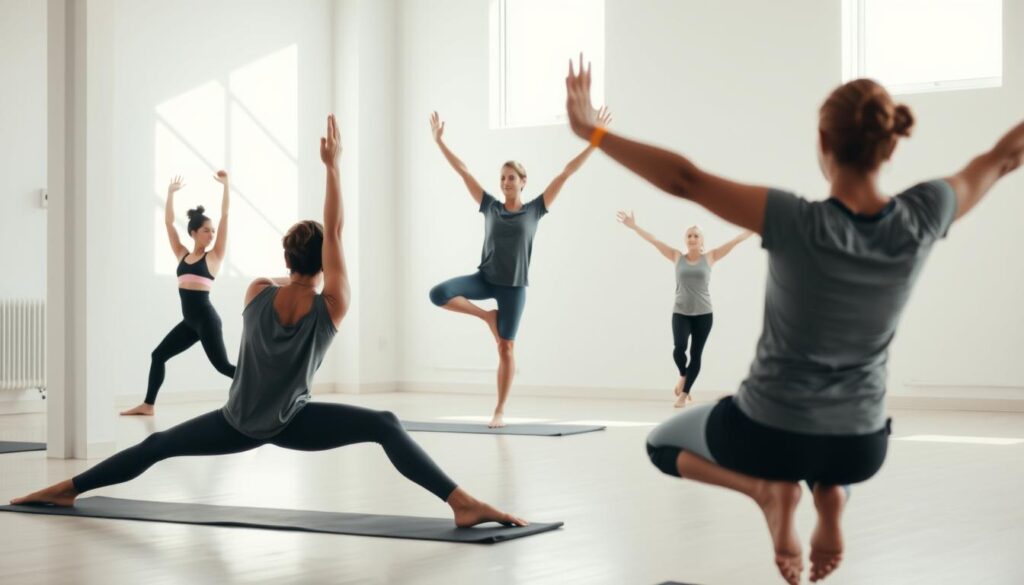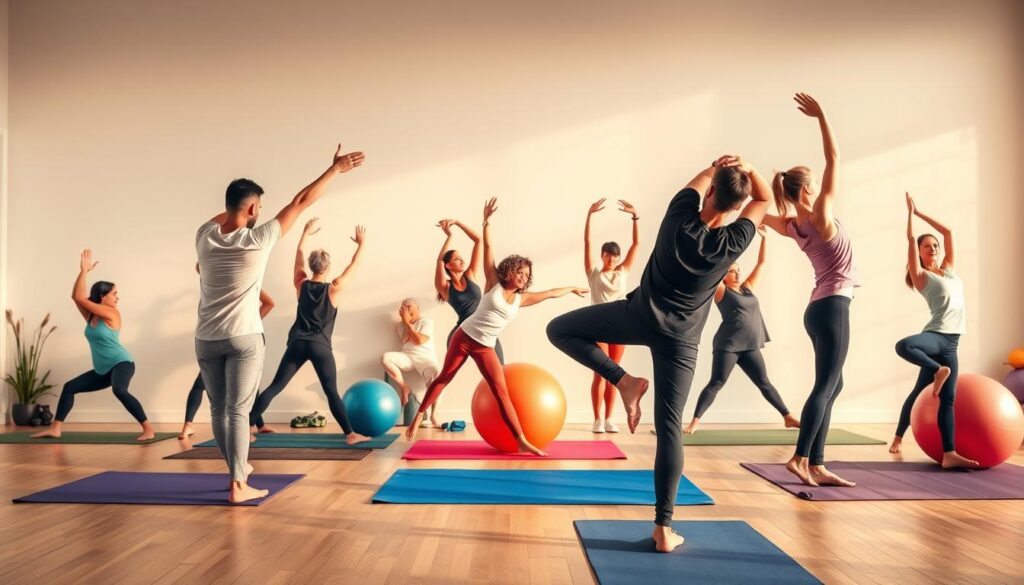Ever thought about how stretching can boost your flexibility? Many people don’t realize how important stretching is. It’s key for improving flexibility. By doing stretching exercises regularly, you can move better and prevent injuries.
Studies from places like the Mayo Clinic show stretching helps with joint movement and daily activities. Exploring different stretching methods can greatly improve your performance and health. Always talk to a doctor before starting a new stretching routine, to make sure it’s safe and right for you.
Key Takeaways
- Stretching exercises for flexibility are vital for improving muscle elasticity.
- Commit to at least 2 to 3 sessions of stretching weekly for noticeable results.
- Hold each stretch for 20 to 30 seconds for optimal effectiveness.
- Dynamic and static stretching both play essential roles in flexibility training.
- Incorporating full-body stretches enhances overall range of motion.
Understanding the Importance of Flexibility
Flexibility is key to good physical health and feeling your best. Doing flexibility exercises regularly boosts your movement range. It also lowers injury risks. By adding daily stretches, you’ll see better sports skills and posture.
Benefits of Improved Flexibility
Being flexible offers many perks for your everyday life. Some of these benefits include:
- Enhanced athletic performance in various sports activities.
- Reduced muscle tension and relief from discomfort.
- Increased blood flow to muscles, contributing to overall muscle effectiveness.
- Greater ease in performing daily tasks, such as walking, bending, and lifting.
- Improved balance and coordination, which gets better with age.
How Flexibility Affects Daily Activities
Flexibility makes everyday movements easier. Regular exercises improve your movement and reduce tiredness when you’re active. This makes doing things easier, from simple tasks to harder physical activities.
Working on equal flexibility on both sides helps avoid injuries. It also supports a balanced lifestyle.
Stretching Exercises for Flexibility
Adding stretching exercises to your routine can boost your flexibility and performance. It’s key to know the different stretching methods. These methods are mainly dynamic stretching and static stretching.
Types of Stretching Techniques
Dynamic stretching involves moving your body in a controlled way. It’s great before working out to get your muscles ready. This helps increase your range of motion and lowers injury risk.
Static stretching, on the other hand, means holding a stretch for about 30 seconds. It’s best after exercising to stretch your muscles and aid in recovery.
Dynamic vs Static Stretching
| Type of Stretching | Description | Recommended Use |
|---|---|---|
| Dynamic Stretching | Involves moving parts of your body through a full range of motion in a controlled manner. | Best before workouts to warm up muscles and prepare for activity. |
| Static Stretching | Involves holding a stretch in a fixed position to target a particular muscle group. | Ideal after workouts to relax muscles and improve flexibility. |
Both dynamic and static stretching are important for flexibility training. For best results, stretch at least 2 to 3 times a week. Focus on big muscle groups and warm up before stretching. Regular stretching improves flexibility and joint health, helping prevent injuries.
Dynamic Stretching for Flexibility
Dynamic stretching is key for better flexibility. It involves moving your muscles and joints before exercise. This makes you move better and lowers injury risk during sports or workouts.
It also warms up your muscles and boosts blood flow. This helps you move at your best.
What is Dynamic Stretching?
Dynamic stretching uses quick, controlled movements. It’s different from static stretching, which holds a stretch for a long time. Dynamic stretching gets your range of motion better and makes you more flexible and mobile.
It’s fast, taking only one to two seconds per stretch. This makes your joints and muscles more flexible and lowers injury risk.
Examples of Dynamic Stretches
Adding dynamic stretches to your warm-up can really help your flexibility. Here are some common ones:
| Dynamic Stretch | Target Areas | Instructions |
|---|---|---|
| Walking Lunges | Hips, Quadriceps | Step forward into a lunge, alternating legs as you walk. |
| Leg Swings | Hamstrings, Hip Flexors | Stand on one leg, swing the opposite leg forward and backward. |
| Arm Circles | Shoulders | Extend arms sideways and make circles, gradually increasing size. |
| Frogger | Hips, Calves | Squat down and jump forward, stretching your legs and hips. |
| Bear Movement | Hamstrings, Shoulders | Crawl forward on hands and feet, keeping your back flat. |
Doing these stretches not only makes you more flexible but also gets you ready for tough workouts. Start with a 5 to 10-minute warm-up, like jogging or swimming. This makes your dynamic stretches more effective. It also makes your workouts more enjoyable and consistent.
Static Stretching Techniques
Adding static stretches to your routine is key for flexibility and muscle recovery. These stretches help stretch tight muscles, keeping you flexible and avoiding stiffness after exercise. Doing these stretches regularly can lessen soreness and boost your fitness.
Hold each stretch for 20 to 45 seconds. Repeat them two to three times for the best results. Remember to breathe deeply, inhaling through your nose and exhaling through your mouth.
Importance of Static Stretching
Static stretching is essential in any fitness plan. It helps realign muscle fibers and restore normal movement after bodyweight exercises. Doing static stretches after a workout can also improve your flexibility.
This is great for runners, as it can lengthen your stride. Unlike dynamic stretches, which can hurt your performance as a warm-up, static stretches are perfect for cooling down.
Effective Static Stretches to Incorporate
Here are some effective static stretches for your cool-down routine:
- Upper Back Stretch
- Shoulder Stretch
- Hamstring Stretch
- Standing Hamstring Stretch
- Calf Stretch
- Hip and Thigh Stretch
- Adductor Stretch
- Standing Iliotibial Band Stretch
- Standing Shin Stretch
- Quadriceps Stretch
These stretches can be done at home and target different muscle groups. For more no-equipment routines and flexibility tips, check out this resource.
Full Body Stretches to Enhance Flexibility
Adding full body stretches to your workout routine is key for better flexibility. These stretches cut down on muscle tension and boost your movement. They make everyday tasks simpler and more efficient. By stretching different parts of your body, you keep your flexibility routine balanced.
Stretching Major Muscle Groups
Working on big muscle groups like your back, legs, and shoulders boosts flexibility. Neck tilts, shoulder rolls, and standing toe touches work many muscles at once. They also improve blood flow. Doing these stretches often can lessen muscle pain, enhance sports performance, and lower injury risk.
Experts say to hold each stretch for about 30 seconds for the best results. For more tips and techniques, check out this flexibility routine article.
Sample Full Body Stretch Routine
Here’s a simple full body stretch routine to follow:
- Neck Stretch: Hold for 10 seconds on each side.
- Shoulder Stretch: Hold for 20 seconds on each side.
- Standing Toe Touch: Hold for 30 seconds.
- Quadriceps Stretch: Hold for 20 to 30 seconds on each leg.
- Hamstring Stretch: Hold for 20 to 30 seconds on each side.
- Calf Stretch: Hold for 20 to 30 seconds on each side.
- Inner Thigh Stretch: Hold for 15 to 30 seconds.
Regularly doing these stretches can greatly improve your flexibility and reduce muscle tightness. Committing to daily stretching, even for a few minutes, will lead to noticeable improvements in your flexibility over time.
Specific Flexibility Exercises
Targeted flexibility exercises are key to better flexibility and mobility. Focusing on muscles like the calves, hamstrings, hip flexors, and quadriceps boosts your range of motion. These exercises improve your daily activities and athletic performance.
Calf and Hamstring Stretches
Calf stretches ease tightness and boost flexibility in your lower legs. Stand facing a wall with one leg back. Lean against the wall, keeping your back leg straight and heel on the ground. Hold for 10 to 30 seconds, repeating 1 to 3 times on each leg.
Hamstring stretches involve lying on your back and raising one leg against a wall. This stretches the hamstring group deeply. Hold for 10 to 30 seconds, repeating 3 to 5 times for each leg. Regular practice of these stretches can lead to significant flexibility gains.
Hip Flexor and Quadriceps Stretches
Hip flexor stretches are vital for those who sit a lot. Start by kneeling on one knee, with the other foot in front. Push your hips forward gently until you feel a stretch in the front of your hip. Hold for 10 to 30 seconds, repeating 1 to 3 times.
Quadriceps stretches involve standing and grabbing your ankle behind you, pulling it towards your glutes. Keep your knees close and maintain a shoulder-width stance. Hold the stretch for 10 to 30 seconds, repeating 1 to 3 times for each foot. These stretches improve leg flexibility and reduce injury risk.
Regularly doing these targeted exercises can greatly improve your daily movements. For more benefits, consider adding Pilates to your routine. Pilates enhances flexibility, stability, and jumping ability through core strength, as explained in this resource.
Creating a Flexibility Training Routine
Creating a routine for flexibility training is key to getting better. Regular stretching keeps you mobile and helps prevent injuries. Adjusting your stretching schedule to fit your life makes it easier to stay consistent.
How Often to Stretch
For the best results, stretch two to three times a week. Stretching more often boosts your skills. Hold each stretch for 30 seconds and repeat it two to four times, based on how comfortable you feel.
Start with two stretches and slowly increase to three and then four. This lets your body adjust. Always stretch after warming up to avoid injuries.
Structuring Your Stretching Sessions
Begin with a 10 to 15-minute warm-up to get your joints ready. Then, move on to standing, seated, and lying down stretches. This covers all major muscle groups.
For the standing calf stretch, stand about a foot away from a wall. For the hamstring stretch, step forward with your front leg while keeping it straight. Adjustments can make these stretches more effective.
Use seated stretches like the neck stretch without leaning back. Lying down stretches like the bicep and knee-to-chest stretches target specific muscles. A consistent routine and well-structured sessions can reduce muscle imbalances and improve mobility.
| Stretch Type | Frequency | Duration | Repetitions |
|---|---|---|---|
| Standing Stretches | 2-3 times/week | 30 seconds | 2-4 times |
| Seated Stretches | 2-3 times/week | 30 seconds | 2-4 times |
| Lying Down Stretches | 2-3 times/week | 30 seconds | 2-4 times |
Safety Tips for Stretching Exercises
Keeping safe while stretching is key to getting the most out of your flexibility. It starts with knowing the right techniques and listening to your body. Always warm up before stretching to get your muscles ready and prevent injuries.
Preventing Injuries While Stretching
Stay away from sudden or bouncy movements when stretching. Stretch slowly and let your muscles adjust. Hold each stretch for 20-30 seconds. If it hurts, start with 10 seconds and increase as you get more flexible.
Stretching safely means stretching to the point of tension, not pain. Regular stretching keeps your muscles flexible and can slow down age-related mobility loss.
Listening to Your Body
It’s important to listen to your body during stretching. If you feel any discomfort, adjust your stretch or make it less intense. A regular stretching routine can reduce muscle tension and improve your mental calmness.
This approach helps with both physical flexibility and emotional well-being.
Conclusion
Adding stretching exercises to your daily routine is key for better flexibility and mobility. Regular stretching can make you up to 30% more flexible, studies show. It’s great for your health and can cut injury risk by half.
When setting up your stretching routine, mix different types of stretches. Do dynamic stretches before working out and static stretches after to help recover. Aim to stretch at least three times a week to stay flexible and avoid injuries. Hold each stretch for 10 to 30 seconds to see real improvements.
Being active in stretching boosts your physical performance and overall health. By sticking to these exercises, you’ll move more easily and feel better. This shows how vital stretching is for your well-being.
FAQ
What are the best flexibility exercises I should include in my routine?
The top flexibility exercises include static stretches like hamstring and quadriceps stretches. Also, don’t forget calf stretches. Dynamic stretches like walking lunges and arm circles are also key. Mixing both types is best for improving flexibility.
How do stretching exercises improve flexibility?
Stretching makes muscles more elastic and joints move better. Regular stretching boosts muscle performance and lowers injury risk.
Is it better to do dynamic stretching before or after workouts?
Do dynamic stretching before workouts to get your muscles ready. Static stretching after helps with recovery and boosts flexibility.
How often should I practice flexibility stretches?
Aim for two to three times of flexibility stretches a week for best results. Daily stretching is even better for keeping flexibility up.
Can I hurt myself while stretching?
Yes, wrong stretching can hurt you. Warm up first, don’t bounce, and stop if it hurts.
What is the difference between dynamic and static stretching?
Dynamic stretching is active, done before exercise to warm up. Static stretching is holding a stretch to lengthen muscles, done after to recover.
Do full body stretches provide specific muscle benefits?
Yes, full body stretches target big muscle groups. They improve flexibility and reduce muscle tightness. Regular full body stretches boost mobility and ease tightness.
How can I incorporate flexibility training into my lifestyle?
Add stretching to your daily life, like while watching TV or before bed. Set aside time for stretching two to three times a week.






